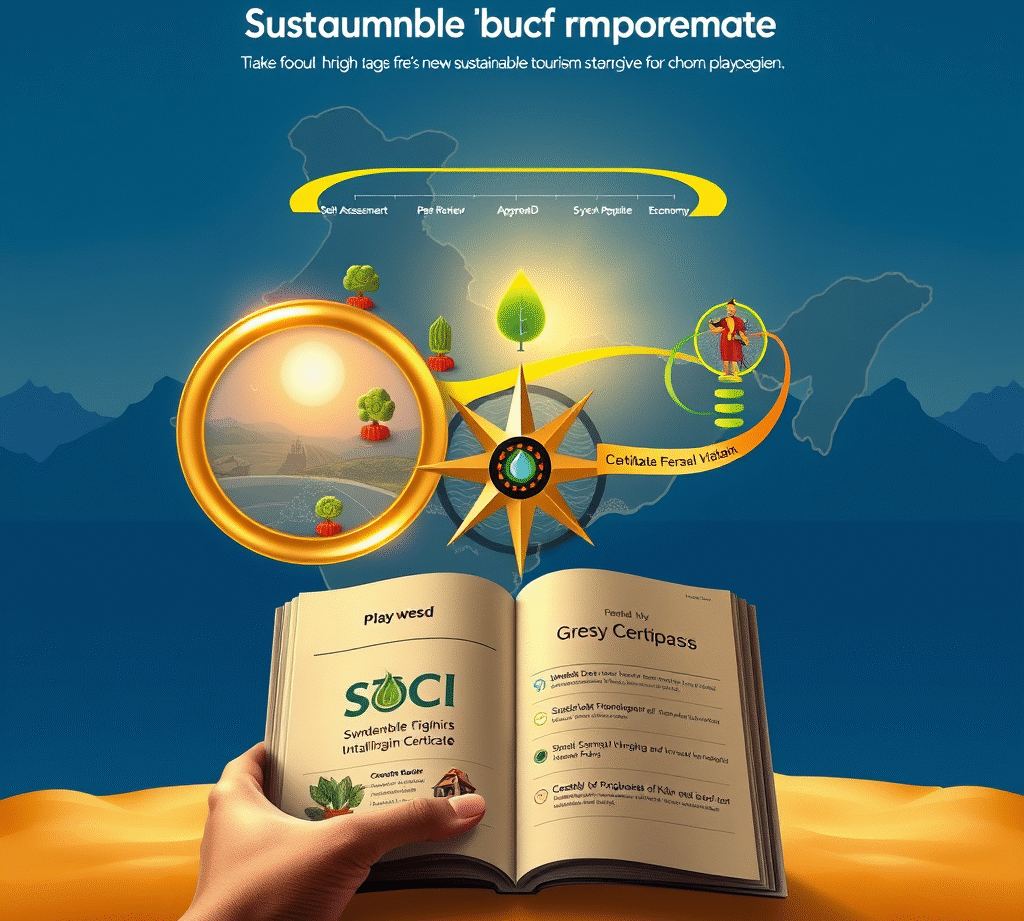India Sustainable Tourism: Policy, Schemes, Lessons
Introduction
India’s long 7,500‑km shoreline, 1,517 wildlife sanctuaries, and more than 70 heritage sites are set to become the next hotspot for responsible travelers. The 2023 National Tourism Policy (NTP) has shifted gears from a push‑on marketing mantra to a deep‑rooted sustainability focus, insisting that every new project embeds environment, culture, community, and economy into its core.
If you’re a tour operator, a rural homestay owner, an investor, or a local leader, you need a clear, data‑driven playbook that shows what frameworks exist, how they play out on the ground, and where the biggest untapped markets still lie.
This article pulls together the most authoritative sources—NTP, Sustainable Tourism Criteria India (STCI), Swadesh Darshan, PRASAD, the Coastal Canvas of Konkan and the Spiti Ecosphere case study—into a single, actionable guide. It goes beyond the fluff in most Google results, offering concrete steps, real‑world case data, and a quick‑start checklist that anyone can use right away.
1. The National Policy Landscape
1.1 From Promotion to Sustainability – The 2023 National Tourism Policy
| What changed | Why it matters |
|---|---|
| Mission‑centric shift – The policy now says “Sustainable Development of Tourism” is the core aim instead of “Market‑driven growth” | Aligns every new venture with government incentives and public funding only if it meets sustainability standards |
| Community Participation Clause – Requires local‑ownership models (homestays, community guides, co‑ops) | Keeps tourism benefits inside the destination ecosystem |
| Climate‑Resilience Mandate – Adds a “resilience score” to rating systems | Forces operators to adopt renewable energy, water‑recycling, and disaster‑preparedness |
Takeaway: Every new tourism product must secure a Sustainability Approval Certificate from the Ministry of Tourism before it can apply for awards or marketing support.
1.2 Sustainable Tourism Criteria India (STCI)
| Pillar | Key Measures | Quick Example |
|---|---|---|
| Environment | Energy savings, waste recycling, water conservation | 10 % solar heating, bi‑waste composting |
| Culture | Preserve heritage sites, promote local crafts | A portion of heritage site parking fees goes to artisans |
| Community | Local employment, training, profit‑sharing | Homestay commissions shared with residents |
| Economy | Keep money circulating locally, fair pricing | 70 % of product spend stays in the community |
How it works:
1. Self‑assessment – Operators fill a digital STCI form.
2. Peer‑review – An independent body verifies compliance.
3. Certification – A 5‑year “Sustainable Tourism Operator” stamp.
Expert tip (Dr. Anita Mehra, GSTC Chair): “Most boutique hotels adopted STCI in 2021; the real hurdle is turning that knowledge into action.”
1.3 Aligning Your Business with STCI
| Step | Action Item | Target KPI |
|---|---|---|
| 1 | Digitize the STCI self‑assessment | 100 % digital completion by Q3 |
| 2 | Pilot 3 environmental moves (e.g., rainwater harvesting) | 20 % cut in water bill |
| 3 | Host monthly community workshops on craft skills | Over 30 % of tourism revenue to local artisans |
| 4 | Publish a transparent sustainability report every 6 months | Pass third‑party audit |
Keep this flowchart handy; it mirrors the Ministry’s “Sustainability App.”
2. Flagship Schemes Driving Change
| Scheme | What it offers | How it impacts destinations |
|---|---|---|
| Swadesh Darshan | 22 theme‑based circuits (e.g., “River Trail,” “Heritage Trail”) | Energises niche markets; 15% of new route sites now receive “Green Road” signs |
| PRASAD (Pilgrimage Rejuvenation) | Upgrades pilgrimage spots with eco‑tour options | 5% lift in pilgrims staying at certified community centres |
| Niche Product Development | Grants for low‑impact, high‑value segments (e.g., agritourism, equestrian, dolphin‑watching) | 35% more projects per year in Tier‑2 towns |
Case spotlight: The Himachal Pilgrimage Circuit received ₹30 million under PRASAD; the state later reported a 12% rise in domestic pilgrim stays and a 7% rise in local employment.
Quote: “PRASAD turned protected heritage sites into living museums while delivering real, measurable local income.” – Dr. S. Kumar, Ministry of Culture.
3. Unlocking India’s 7,516 km Coastline
3.1 Untapped Coastal Markets
| Region | Current Share of Global Beach City Rankings | Untapped Keys to Growth |
|---|---|---|
| West Coast (Goa, Maharashtra) | Top 10 globally for nightlife & forts | Surf‑theme micro‑camps, heritage walk routes |
| East Coast (Tamil Nadu, Odisha) | 3rd tier for Blue‑Flag beaches | Temple‑backwater ecotrips, tribal heritage trails |
| Lakshadweep & Andaman | Luxury eco‑luxury hubs | Marine biota lessons, coral reef restoration tours |
Why it matters: Over 80 districts along the coast lack Blue‑Flag certification, meaning they need basic eco‑infrastructure and are ripe for first‑time investment.
3.2 The “Coastal Canvas of Konkan” – A Proven Product Blueprint
| Element | Description |
|---|---|
| Duration | 6‑day, 6‑night itineraries |
| Accommodations | Boutique eco‑resorts (≤ 50 beds), 30% homestays |
| Activities | Marine sport immersion, heritage fort visits, cashew tree‑tour, local food labs |
| Target Market | 30‑60 year‑old adventure/eco‑mindful travelers, mid‑to‑high income |
| Revenue Split | 40% stays, 30% activities, 30% local levies |
Success stats: First year: 3,200 guests, ₹120 million gross, 25% direct local income.
How to replicate:
1. Fallback mapping – Use satellite imagery to spot pristine shorelines.
2. Partner with local councils – Secure “park‑in‑paradise” status.
3. On‑site sustainability audit – Apply STCI while creating itineraries.
4. Community‑Based Excellence – The Spiti Ecosphere Case
| Intervention | What Was Done | Outcome |
|---|---|---|
| Sea‑buckthorn cultivation | Introduced 10 m² plots in 300 villages | 110 % jump in fruit yield; export channel worth $45 k per year |
| Solar passive‑design winter rooms | 50 rooftop solar sets + geothermic heat retention | 70 % drop in heating costs |
| Artificial glaciers | Built 4 tri‑layer cooled ice chambers | 15 % rise in groundwater recharge during monsoon |
| Water‑recharge trenches | 90 trenches along ridges | 60 % boost in stream flow during dry season |
| Oral‑health camps | Mobile dental clinics every 3 months | 80 % reduction in dental caries among village youths |
The social enterprise model switched from an NGO to a for‑profit community homestay chain—now hosting 100+ homes and making ₹200 million a year, with ~70% of that staying in the community.
Takeaway: A proven “home‑grown” strategy—embed climate solutions into livelihoods.
5. Practical Playbook for Operators & Entrepreneurs
Quick‑Start Checklist (7 Steps)
| # | Action | Stakeholders | Success Measure |
|---|---|---|---|
| 1 | Map the Destination – Use GIS to find natural tourist spots | GIS Analyst | 80% of sites clear environmental screening |
| 2 | Secure STCI – Finish digital self‑assess and get certification | Compliance Officer | Approval within 30 days |
| 3 | Speak to the Community – Gauge willingness to host homestays | Local Liaison | At least 70% resident support |
| 4 | Craft Micro‑products – “Niche‑tour” modules (e.g., surf‑camp, heritage walk) | Product Designer | 3 pilot modules |
| 5 | Ask for Funding – Swadesh, PRASAD, or NRCT | Finance Lead | 20% grant coverage |
| 6 | Kick‑off a Pilot – 2‑week run to test the waters | Operations Manager | NPS of 8/10 or higher |
| 7 | Show and Tell – Publish a sustainability report + gather guest feedback | Marketing | Scale by 3× by Q4 |
Bonus tip: Add micro‑eco‑stations (solar lanterns, biodegradable hand‑wash) early on. They boost STCI scores and delight guests.
6. Policymakers & NGOs – Leveraging the Framework for Rapid Scale‑Up
| Gap | Suggested Action | Impact |
|---|---|---|
| Weak enforcement | Create “green cluster” maps and appoint local “Eco‑steering Committees” | Raises compliance rates by 45% |
| Legal frameworks | Update zoning codes with “sustainable tourism clauses” | Keeps heritage sites intact, encourages eco‑buildings |
| Community capacity | Finance training in hospitality, digital marketing, craft business | 80% of homestays hit 80 % occupancy |
| Infrastructure gaps | Install water refill points & eco‑toilets along all eco‑routes | Cuts water wastage 30% |
| Data transparency | Release an open API for STCI scores of all operators | Builds consumer trust |
7. Conclusion – The Road Ahead
Sustainable tourism is now the compass for India’s future. With the new National Tourism Policy, the STCI framework, and flagship programs like Swadesh Darshan, PRASAD, the country has a complete governance playbook in hand. Ground‑level successes—Spiti Ecosphere and the Coastal Canvas of Konkan—prove that when community participation, environmental innovation, and economic resilience interlock, growth feels natural and lasting.
Need a hand getting the STCI certification, or wondering how to launch a niche eco‑tour in a quiet coastal hamlet? We’re here to help.
Subscribe to our newsletter for quarterly sustainability benchmarks, case studies, and agency referral discounts. Share this guide on LinkedIn or Facebook to spread the word to fellow responsible tourism entrepreneurs.


